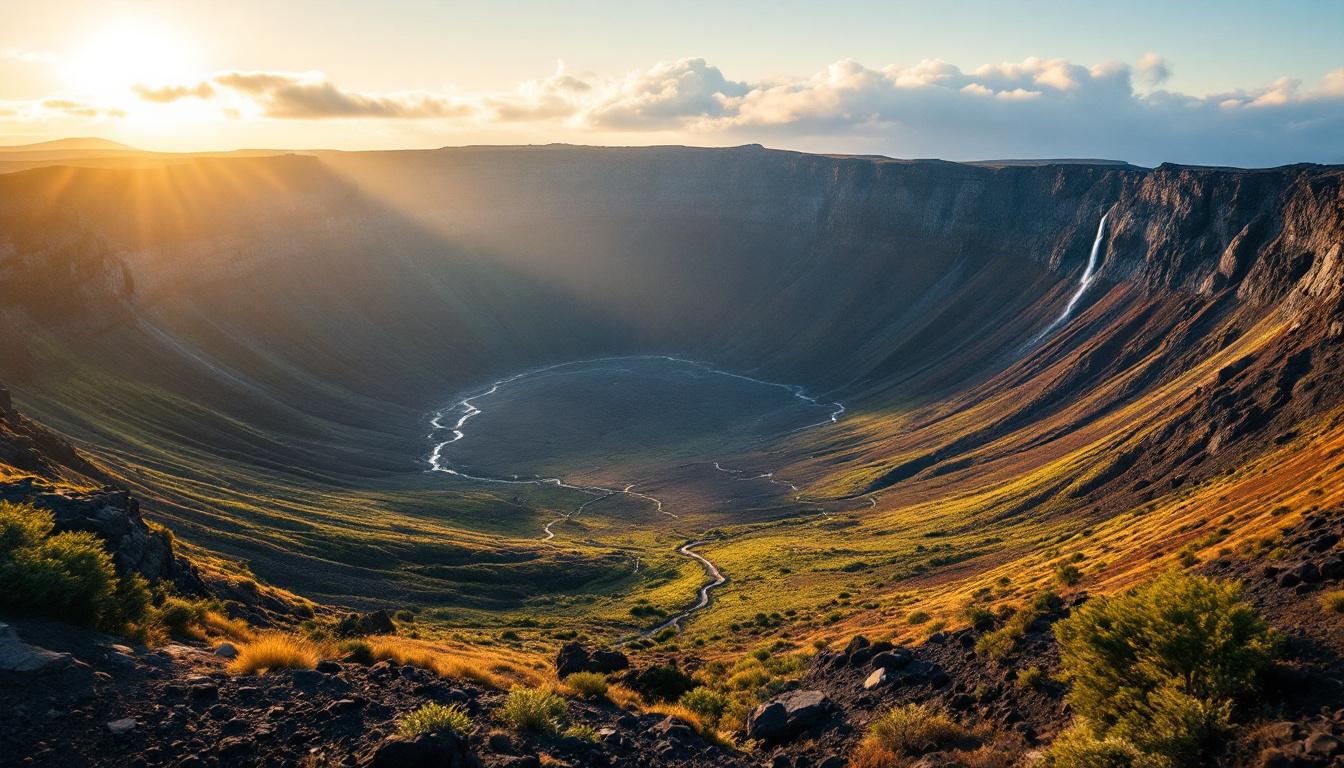When I first gazed into the 8-kilometer-wide volcanic caldera of La Palma’s Caldera de Taburiente, I realized I was standing at the edge of something no other European island could offer. This isn’t just another Canary Island experience—it’s the continent’s most exclusive geological wonder.
While crowds flock to Tenerife’s overcrowded beaches, La Palma quietly guards Europe’s largest accessible volcanic caldera and the world’s most advanced stargazing observatory. The locals call it “La Isla Bonita” for good reason—it’s the only place where you can hike inside an ancient volcanic basin by day and observe distant galaxies through professional telescopes by night.
This protected paradise offers what no other European destination can match: the rare combination of geological exclusivity and astronomical perfection wrapped in authentic Canarian culture that mass tourism hasn’t touched.
The volcanic caldera that defines European uniqueness
Standing inside Europe’s geological masterpiece
The Caldera de Taburiente stretches 8 kilometers across and plunges 2,000 meters deep, carved by millions of years of volcanic collapses and erosion. No other European island offers anything comparable in scale or accessibility—you can actually hike trails that wind through this ancient volcanic amphitheater, surrounded by towering basalt walls and cascading waterfalls.
Hiking trails that exist nowhere else in Europe
The caldera’s hiking network includes the Ruta de los Volcanes, where you’ll traverse volcanic ridges and descend into the basin itself. Unlike crowded tourist trails elsewhere, these paths require advance parking reservations and maintain strict visitor limits, ensuring you’ll experience this geological wonder without the crowds that plague other European natural sites.
The astronomical observatory that outshines everything else in Europe
Eighteen telescopes at 2,400 meters elevation
The Roque de los Muchachos Observatory houses 18 telescopes operated by 22 countries, positioned above the cloud line where light pollution laws have been enforced since 1988. This UNESCO Starlight Reserve status makes it the world’s only legally protected dark-sky observatory, offering views of both northern and southern celestial hemispheres that no other European location can provide.
Stargazing conditions impossible to find elsewhere
July through August delivers optimal stargazing with minimal moonlight interference and crystal-clear skies. The Mirador de Llano del Jable at 1,341 meters provides public access to professional-grade viewing conditions that surpass anything available on mainland Europe or other Atlantic islands.
The protected status that makes exclusivity possible
National park restrictions that preserve authenticity
Both the caldera and observatory areas maintain Biosphere Reserve status with controlled access that prevents overtourism. You’ll need to book parking in advance and follow designated hiking trails, but these restrictions ensure the pristine conditions that make La Palma special—something mass-market destinations like Tenerife lost decades ago.
Local preservation efforts you won’t find on other islands
The Canarian government enforces strict lighting regulations and development limits that protect both the night sky and volcanic landscapes. This commitment to preservation means you’ll experience authentic island culture without the resort developments and cruise ship crowds that dominate other Canary Islands.
The authentic island experience mass tourism destroyed elsewhere
Traditional villages untouched by resort development
La Palma’s 84,500 residents maintain traditional banana farming, artisan crafts, and local festivals that feel genuinely welcoming rather than performed for tourists. The capital, Santa Cruz de La Palma, offers authentic Canarian architecture and local restaurants where residents actually eat, not tourist traps designed for cruise passengers.
Natural beauty without the environmental damage
The island’s volcanic soil supports lush forests and endemic flora that thrive in protected microclimates. You’ll hike through laurel forests and volcanic ravines that showcase the Canary Islands’ natural beauty before mass development altered other islands’ ecosystems.
La Palma proves that some places become more valuable when they remain difficult to reach and impossible to replicate. The combination of Europe’s largest volcanic caldera, world-class astronomical facilities, and protected cultural authenticity creates an experience that no other European island can offer.
This July, while other travelers fight crowds in Tenerife or Lanzarote, you could be hiking inside an ancient volcanic crater and stargazing through telescopes that reveal distant galaxies. The only question is whether you’re ready for Spain’s hidden medieval town that feels like stepping into a fairytale, or if you prefer this wetland paradise where flamingos outnumber tourists, or perhaps the Japanese island where wildcats roam free for your next authentic adventure.
Essential planning for your La Palma adventure
When should I visit La Palma for the best experience?
July through September offers optimal weather for both hiking and stargazing, with minimal rainfall and clear skies. Book caldera hiking permits and observatory visits in advance, as daily visitor numbers are strictly limited to preserve the experience.
How do I access the volcanic caldera safely?
The Caldera de Taburiente requires moderate hiking fitness and proper equipment. Start from the La Cumbrecita viewpoint for easier access, or tackle the full descent from Roque de los Muchachos for experienced hikers seeking the complete volcanic experience.
What makes La Palma’s stargazing superior to other locations?
The combination of high altitude, legal light pollution protection, and professional-grade equipment access creates stargazing conditions unmatched in Europe. The observatory offers public viewing sessions that let you experience the same telescopes used by international researchers.
How is La Palma different from Tenerife or Lanzarote?
La Palma focuses on natural preservation and authentic culture rather than mass tourism. You’ll find hiking trails instead of water parks, local restaurants instead of resort buffets, and genuine cultural experiences instead of tourist shows designed for cruise passengers.
What should I know about respectful tourism on La Palma?
Follow designated trails, respect parking restrictions, and support local businesses rather than international chains. The island’s beauty depends on visitors who appreciate conservation efforts and contribute to sustainable tourism that benefits local communities.
